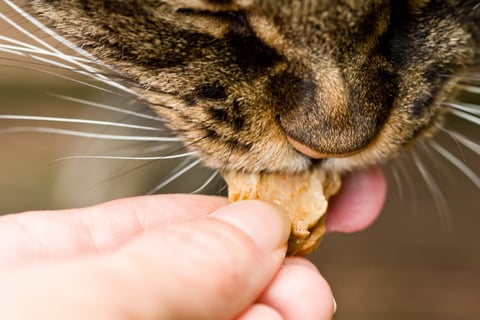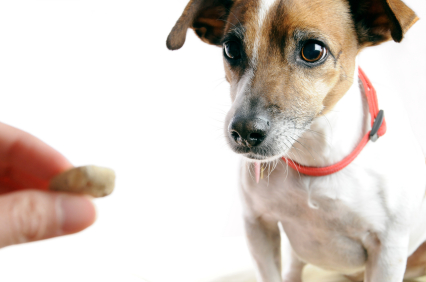Train your pet using reinforcement and rewards
The best way to train a pet is through the appropriate use of positive reinforcement and rewards while avoiding punishment. The goal of training is to “learn” the correct task and/or behavior. First, you must be able to reliably get the pet to perform the desired behavior. Then, precede the behavior with a prompt or command so that it can be started by command or prompt alone. Of course, rewards can and should be given for any desirable behavior, not just those associated with commands. Often, the most difficult aspect of training is finding techniques that will immediately get the desired response after each command. Before effective training can take place, you must first understand how pets learn and how to effectively use rewards to achieve desired behaviors.
What is positive reinforcement?
Positive reinforcement is anything that increases the likelihood that a behavior will repeat itself. There is a positive relationship between behavior and consequences. The more the pet performs the behavior, the more consequences it gets, and the ones it gets are good ones. This increases the behavior.
What do dogs consider positive reinforcement?
This can vary from dog to dog and can vary depending on the time of day or from individual to individual. For some dogs, it might be a stroke of the head, playtime, a fun toy, a walk, or a food reward. The key is to choose rewards that motivate your dog. Petting and affection can be excellent rewards when the dog wants these interactions, but if the dog is not emotionally involved, or the affection is being given by someone it doesn’t want attention from, then it can be a source of fear and anxiety.
To increase motivation for a particular reward, it may be useful to wait until the dog seems interested in the reward and can be further improved by retaining the reward. For example, if you only give your dog one or two pre-ordered meals, training sessions that use food and treats should be most successful as the dog gets hungrier and closer to meal time. Most puppies can be motivated with scraps of food when hungry, but different treats or rewards are often more attractive because of their novelty. Similarly, toys, playtime, and intimacy can be reserved for training time, so that the dog is “hungrier” for these rewards, and the dog learns which behaviors will be rewarded.
Similarly, if we wait until the cat is motivated, we can train the cat by petting and playing with toys and food.
The more predictable the reward, the more likely the pet is to continue the behavior (see Training your Dog with predictable rewards). On the other hand, if the reward is unpredictable (for example, intimacy), the pet will not be able to learn the desired response.
How do I use positive reinforcement correctly?
Using positive reinforcement properly is more than just giving a reward or a pat on the head.
The timing of reinforcement is very important. Remember, your pet is always engaged in behavior. So, you need to make sure that you reinforce the behavior you want and not the other behavior. Therefore, tie reinforcement closely to the behavior you want to increase. Reinforcement must follow the behavior. If there is any delay, you run the risk that the pet will engage in another behavior while you perform the reinforcement. One example is when you teach a dog to sit. You tell your dog to “sit” and manipulate it into position. If you say “good dog” and give a food reward when the dog stands up or starts barking, you won’t reward sitting down. Instead, you may have rewarded a standing up, barking, or sit-stand-barking sequence. Another example is when you are toilet training your dog. You send the dog outdoors to relieve himself, and as soon as the dog is done, you call the dog back into the house, dry his feet and give him a treat. What happened this time? You have just rewarded your dog by returning to the house and drying its feet!
Should I reward my pet every time?
The frequency of reinforcement is important. The rate at which the behavior is reinforced is called the “schedule.” There are several different schedules for reinforcement.
A. Continuous reinforcement: Every time your pet performs A behavior, it is reinforced with a reward. While this sounds like a good idea, it’s actually not ideal. If you continuously reward a behavior, as soon as you stop rewarding that behavior, it usually stops. Continuous reinforcement is useful when initially teaching new tasks, so that animals can learn tasks that lead to good outcomes. In fact, for new tasks, like rewards, small reward prizes, or clicker training (see Clicker and target training) can be given the first few times so that pets quickly learn these are highly desirable behaviors.
B. Ratio or variable rate reinforcement: Reinforcement does not occur after every performance, but is intermittent. This means that, instead of a reward every time, the pet might get a reward after every three acts, then maybe twice in a row, and then maybe not until the pet has performed five acts. What would happen if you did that? The behavior tends to be stronger and last longer. This type of reinforcement is best implemented after the pet reliably knows the task you wish to teach and helps keep the pet responding at a high rate.
Which reinforcement schedule is best for training?
Start training a new command or task with continuous reinforcement, but once your pet responds in unison, switch to an intermittent, variable rate. When training pets, we often use preferred rewards (even clicker training – see Clicker and target training) to continuously achieve the behavior we want to train, and when the behavior is learned, we often switch to fewer rewards, such as petting or praise, and only intermittently give more popular rewards.
What if my rewards don’t work?
First, you may not be reinforcing the right tasks. Remember the “sit down” and “stand up” examples. Make sure your reinforcement is timed correctly (i.e., immediately after the behavior you wish to increase). Second, you may have gradually reduced your reinforcement before your pet has fully learned the new behavior. Go back to basics and make sure your pet understands what you want it to do.
Until your dog responds consistently when given a command for the first time, it may be valuable to keep the leash so that you can immediately and gently show it what you want it to do. You may also repeat the command several times or give it in a different way, confusing your pet. Another common problem occurs when you use a food or toy lure to help achieve the initial behavior. If you don’t replace a closed hand cue or move to a command, then the pet will respond by seeing a reward cue instead of a hand signal or word.
Which reward should I use?
The reward doesn’t always have to be food. In fact, there are two forms of reward. The first is a reward that motivates your dog, such as food, toys, or treats; The second is a time of day when your dog seeks intimacy, attention, play, walking, or going outside.
“The reward doesn’t always have to be food.”
For many dogs, attention from their owners, a walk in the park or a game of catch can be a reward. In fact, any time your dog wants some social interaction, any time you give toys, food, or treats, you have the perfect opportunity to train your dog to execute commands. If you don’t keep track of when and where you give rewards, you may actually be reinforcing bad behavior (see below). It is important that it is appropriate and motivating for your dog. Remember that you don’t need to give a “special” reward, such as a treat, every time to complete your dog’s task, but always acknowledge good behavior, even if it’s just with praise or affection.
If you use a reward other than food, you can both train your dog and make sure you’re not giving any extra calories. However, if you use food as a reward, it’s not a problem as long as you count the number of calories in the reward and cut out an equal amount of food. Working for food is a form of social interaction and enrichment for your dog, so it may actually be preferable to feeding all the food from a bowl (see Working for Food and training your dog with predictable rewards).
Which reward should I use for my cat?
Cats respond to training like dogs, however, they appear to require higher frequencies of reinforcement to maintain performance. Food is usually the best reinforcement for cats, but many cats will also enjoy a session with a favorite toy.
“Think of toys and snacks as rewards, not treats.”
Like dogs, small pieces of human food or special cat treats with high appeal may be more important than regular food

















